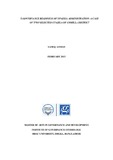E-governance readiness of upazila administration: a case of two selected upazila of Comilla district
Abstract
At the edge of globalization and technological advancement, public sector administration has to face an immense pressure. To cope with the mounting pressure the government has to be prompt, responsive, transparent and citizen-centric. It is beyond doubt that ICT backed government can ensure the desired services of the citizens and thus ICT integrated E-Governance has become a fashionable phrase to articulate the citizens’ demand to a reality creating values to their life. Keeping this in mind, the study has made an attempt to assess the e-readiness level of Upazila Administration of Comilla as a functional unit of field level bureaucracy from the perspective of both the officials and the beneficiaries. It has also attempted to identify the major factors that hinder the e-readiness initiatives of Upazila Administration of Comilla district.
For the purpose of the study, primary data are collected by using questionnaire survey and interview method. Then the findings from the primary data have been crossed verified with the benchmark of the ‘UN Five Stage Model of E-Governance’ to have an overall scenario of e-readiness of Upazila Administration of Comilla district. In the study human capital, lack of infrastructure and logistics, web presence and perception of beneficiaries are taken into consideration as independent variables for verifying the dependent variable, E-Governance Readiness. The study reveals that the capability of officials in using computer is not up to the mark and their utilization level of computer facilities at workplace is considerably low, but surprisingly the younger officials tend to have more capability in using computer. Hence, in terms of human capital, the overall readiness level of Upazila Administration of Comilla district is found to be unsatisfactory. In case of infrastructure and logistics, it is found that the offices have reasonable support of infrastructure and logistics and the trend in using computer and internet by the employee is gradually increasing. So, lack of infrastructure and logistics has deemed to be minimal effect on e-readiness at the field level administration right now. As per web presence concerned, the study reveals that every office has website of its own and this website possesses various forms, notice, examination results, application form for MPO, health related information, agriculture related information etc. but it is inconsistent that almost every website is deemed to be static rather than interactive. In context to perception of the beneficiaries, it is observed that most of the beneficiaries or the citizens are aware of the need of use of ICTs in the public administration.

